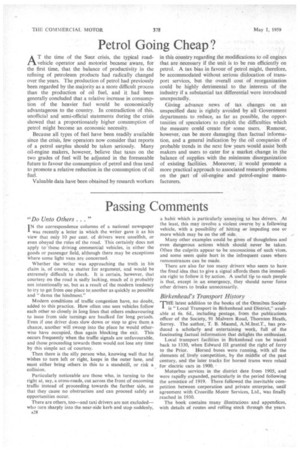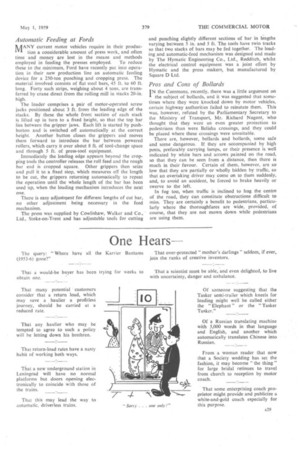Passing Comments
Page 30

Page 31

If you've noticed an error in this article please click here to report it so we can fix it.
"Do Unto Others.
I N the correspondence columns of a national newspaper was recently a letter in which the writer gave it as his view that only 10 per cent. of drivers were unselfish, or even obeyed the rules of the road. This certainly does not apply toithose driving commercial vehicles, in either the goods or passenger field, although there may be exceptions Where some light vans are concerned.
Whether the writer was approaching the truth in his claim is, of course, a matter for argument, and would be extremely difficult to check. It is certain, however, that courtesy on the road is sadly lacking, much of it probably not intentionally so, but as a result of the modern tendency to try to get from one place to another as quickly as possible and "damn the hindmost."
Modern conditions of traffic congestion have, no doubt, added to this practice. How often one sees vehicles follow each other so closely in long lines that others endeavouring to issue from side turnings are baulked for long periods. Even if one driver does slow down or stop to give them. a chance, another will swoop into the place he would otherwise have occupied, thus again blocking the exit. This occurs frequently when the traffic signals are unfavourable, and those proceeding towards them would not lose any time by this simple act of courtesy.
Then there is the silly person who, knowing well that he wishes to turn left or right, keeps in the outer lane, and must either bring others in this to a standstill, or risk a collision.
Particularly noticeable are those who, in turning to the right at, say, a cross-roads, cut across the front of oncoming traffic instead of proceeding towards the farther side, so that they cause no obstruction and can proceed safely as opportunities Occur.
There are others, too—and taxi drivers are not excluded— who turn sharply into the near-side kerb and stop suddenly, A28 a habit which is particularly annoying to bus drivers. At the least, this may involve a violent swerve by a following vehicle, with a possibility of hitting or impeding one or more which may be on the off side.
Many other examples could be given of thoughtless and even dangerous actions which should never be taken. Often the culprits appear to be unconscious of such vices, and some seem quite hurt in the infrequent cases where remonstrances can be made.
There are also far too many drivers who seem to have the fixed idea that to give a signal affords them the immediate right to follow it by action. A useful tip to such people is that, except in an emergency, they should never force other drivers to brake unnecessarily.
Birkenhead's Transport History
THE latest addition to the books of the Omnibus Society is "Local Transport in Birkenhead and District," available at 6s. 6d., including postage, from the publications officer of the Society, 91 Malvern Road, Thornton Heath, Surrey. The author, T. B. Maund, A.M.Inst.T., has produced a scholarly and entertaining work, full of the fascinating factual information that delights the enthusiast.
Local transport facilities in Birkenhead can be traced back to 1330, when Edward III granted the right of ferry to the Prior. Horsed buses were running, with all the elements of lively competition, by the middle of the past century, and the later tracks for horsed trams were relaid for electric cars in 1900.
Motorbus services in the district date from 1905, and were rapidly expanded, particularly in the period following the armistice of 1919. There followed the inevitable competition between corporation and private enterprise, until agreement with Crosville Motor Services, Ltd., was finally reached in 1930.
The book contains many illustrations and appendices, with details of routes and rolling stock through the years
Automatic Feeding at Fords
MANY current motor vehicles require in their production a considerable amount of press work, and often time and money are lost in the means and methods employed in feeding the presses employed. To reduce these to the minimum, Ford have recently put into operation in their new production line an automatic feeding device for a 250-ton punching and cropping press. The material involved consists of flat steel bars, 45 ft. to 60 ft. long. Forty such strips, weighing about 4 tons, are transferred by crane direct from the rolling mill in stacks 20-in. Ii igh The loader comprises a pair of motor-operated screw jacks positioned about 3 ft. from the leading edge of the stacks. By these the whole front section of each stack is lifted up in turn to a fixed 1-might, so that the top bar lies between the gripper jaws. Each lift is started by pushbutton and is switched off automatically at the correct height. Another button closes the grippers and moves them forward to introduce the bar between powered rollers, which carry it over about 8 ft. of tool-change space and through 5 ft. of press-tool equipment.
Immediately the leading edge appears beyond the cropping tools the controller releases the roll feed and the rough bar end is cropped square. Other grippers then seize and pull it to a fixed stop, which measures off the length to be cut, the grippers returning automatically to repeat the operation until the whole length of the bar has been used up, when the loading mechanism introduces the next one.
There is easy adjustment for different lengths of cut bar, no other adjustment being necessary in the feed mechanism.
The press was supplied by Cowlishaw, Walker and Co., Ltd., Stoke-on-Trent and has adjustable tools for cutting
and punching slightly different sections of bar in lengths varying between 5 in. and 5 ft. The tools have twin tracks so that two stacks of bars may be fed together. The loading and automatic-feed mechanism was designed and made by The Hymatic Engineering Co., Ltd., Redditch, whilst the electrical control equipment was a joint effort by Hymatic and the press makers, but manufactured by Square D Ltd.
Pros and Cons of Bollards
IN the Commons, recently, there was a little argument on I the subject of bollards, and it was suggested that sometimes where they were knocked down by motor vehicles, certain highway authorities failed to reinstate them. This was, however, refuted by the Parliamentary Secretary to the Ministry of Transport, Mr. Richard Nugent, who thought that they were an even greater protection to pedestrians than were Belisha crossings, and they could be placed where these crossings were unsuitable.
There are, however, bollards and bollards, some safe and some dangerous. If they are accompanied by high posts, preferably carrying lamps, or their presence is well indicated by white bars and arrows painted on the road, so that they can be seen from a distance, then there is much in their favour. Certain of them, however, are so low that they are partially or wholly hidden by traffic, so that an overtaking driver may come on to them suddenly, and, to avoid an accident, be forced to brake heavily or swerve to the left.
In fog too, when traffic is inclined to hug the centre of the road, they can constitute obstructions difficult to miss. They are certainly a benefit to pedestrians, particularly where the thoroughfares are wide, provided, of course, that they are not mown down while pedestrians are using them.




































































































